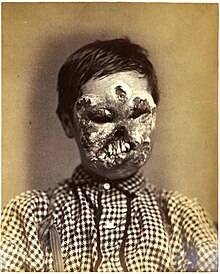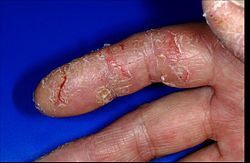
Plastic surgery is a surgical specialty involving the restoration, reconstruction, or alteration of the human body. It can be divided into two main categories: reconstructive surgery and cosmetic surgery. Reconstructive surgery includes craniofacial surgery, hand surgery, microsurgery, and the treatment of burns. While reconstructive surgery aims to reconstruct a part of the body or improve its functioning, cosmetic surgery aims to improve the appearance of it. A comprehensive definition of plastic surgery has never been established, because it has no distinct anatomical object and thus overlaps with practically all other surgical specialties. An essential feature of plastic surgery is that it involves the treatment of conditions that require or may require tissue relocation skills.

The Joker is a supervillain appearing in American comic books published by DC Comics. The character was created by Bill Finger, Bob Kane, and Jerry Robinson, and first appeared in the debut issue of the comic book Batman on April 25, 1940. Credit for the Joker's creation is disputed; Kane and Robinson claimed responsibility for the Joker's design while acknowledging Finger's writing contribution. Although the Joker was planned to be killed off during his initial appearance, he was spared by editorial intervention, allowing the character to endure as the archenemy of the superhero Batman.
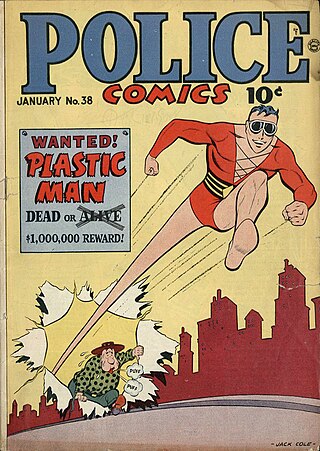
Plastic Man is a superhero first appearing in Police Comics #1, originally published by Quality Comics and later acquired by DC Comics, appearing in their American comic books. Created by cartoonist Jack Cole, Plastic Man was one of the first superheroes to incorporate humor into mainstream action storytelling. This character has been published in several solo series and has interacted with other characters such as Batman and many others in the mainstream DC Universe as a member of the Justice League. He has additionally appeared in several television and video game adaptations, including a television show of his own named The Plastic Man Comedy/Adventure Show.

The Scarecrow is a supervillain appearing in American comic books published by DC Comics. Created by Bill Finger and Bob Kane, the character first appeared in World's Finest Comics #3, and has become one of the superhero Batman's most enduring enemies belonging to the collective of adversaries that make up his rogues gallery.
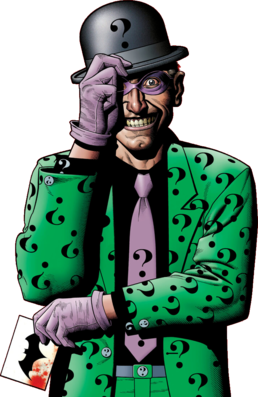
The Riddler is a supervillain appearing in American comic books published by DC Comics. The character was created by Bill Finger and Dick Sprang, and debuted in Detective Comics #140 in October 1948. He has become one of the most enduring enemies of the superhero Batman and belongs to the collective of adversaries that make up his rogues gallery.
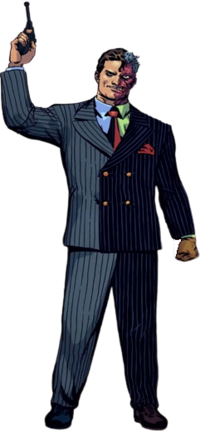
Two-Face is a supervillain appearing in comic books published by DC Comics, commonly as an adversary of the superhero Batman. The character was created by Bob Kane and first appeared in Detective Comics #66. As one of Batman's most enduring enemies, Two-Face belongs to the collective of adversaries that make up Batman's rogues gallery.

Batman: The Killing Joke is a 1988 DC Comics one-shot graphic novel featuring the characters Batman and the Joker written by Alan Moore and illustrated by Brian Bolland. The Killing Joke provides another origin story for the supervillain the Joker, loosely adapted from the 1951 story "The Man Behind the Red Hood!", which was written by Batman co-creator Bill Finger. The Joker's supposed origin is presented via flashback, while simultaneously depicting his attempt to drive Jim Gordon insane and Batman's desperate attempt to stop him.
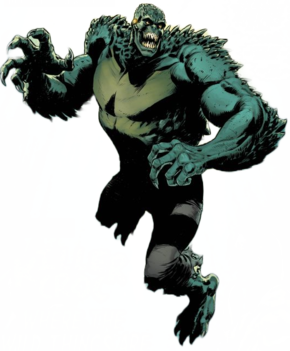
Killer Croc is a supervillain appearing in American comic books published by DC Comics. Created by Gerry Conway, Don Newton and Gene Colan, the character was introduced in Batman #357. He has become one of the most enduring enemies of the superhero Batman and belongs to the collective of adversaries that make up his rogues gallery.

A face transplant is a medical procedure to replace all or part of a person's face using tissue from a donor. Part of a field called "Vascularized Composite Tissue Allotransplantation" (VCA) it involves the transplantation of facial skin, the nasal structure, the nose, the lips, the muscles of facial movement used for expression, the nerves that provide sensation, and, potentially, the bones that support the face. The recipient of a face transplant will take life-long medications to suppress the immune system and fight off rejection.
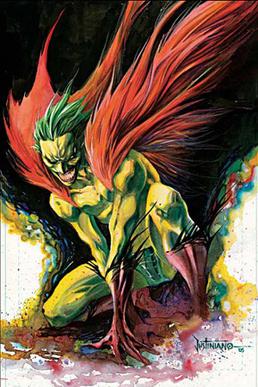
The Creeper is a superhero created by Steve Ditko and Don Segall for DC Comics. He is portrayed as a journalist and talk show host, usually living in Gotham City, who gains the ability to transform into the superhuman the Creeper thanks to experimental science developed by Dr. Yatz. First appearing in Showcase #73, his origin was revised in Secret Origins #18 in 1987, then partially revised again in The Creeper #1–4 in 1997, then completely reimagined in the six-issue miniseries The Creeper, published in 2006–2007.

Batman: The Man Who Laughs is a one-shot prestige format comic book written by Ed Brubaker and drawn by Doug Mahnke, released in February 2005, and intended as a successor to Batman: Year One.

Hush is a supervillain appearing in American comic books published by DC Comics. Created by Jeph Loeb and Jim Lee, the character first appeared in Batman #609 in January 2003 as part of the twelve-issue storyline Batman: Hush. Hush serves as a criminal foil to the superhero Batman and belongs to the collective of adversaries that make up his rogues gallery.
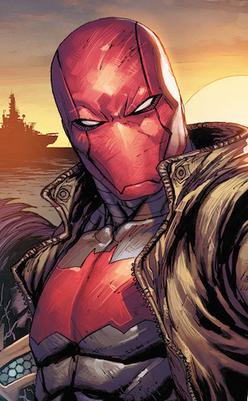
The Red Hood is an alias used by multiple characters appearing in American comic books published by DC Comics. The identity was first used in the 1951 story line "The Man Behind the Red Hood!", which provides the earliest origin story for the Joker. The storyline depicts an unnamed criminal wearing a red dome-shaped hood who, after a chance encounter with Batman, is disfigured by chemicals and becomes insane, giving birth to his future Joker persona.

Jigsaw is a fictional character appearing in American comic books published by Marvel Comics. Created by writer Len Wein and artist Ross Andru, the character made his first full appearance in The Amazing Spider-Man #162. He is depicted as an enemy of the Punisher and Spider-Man as well as a recurring foe of Daredevil.

Batmen of All Nations are a group of fictional superheroes appearing in American comic books published by DC Comics. The characters were inspired by the superhero Batman to fight crime in their respective countries. The group first appeared in Detective Comics #215. Later the Batmen of All Nations were renamed the International Club of Heroes, often known as just the Club of Heroes. Post-Crisis on Infinite Earths, they were named the Dome and were not inspired by Batman but the Justice Society of America.

The Joker, a supervillain in DC Comics and archenemy of the superhero Batman, has appeared in various media. WorldCat records over 250 productions featuring the Joker as a subject, including films, television series, books, and video games. Live-action films featuring the character are typically the most successful.

"Batman: Death of the Family" is a 23-issue comic book story arc first published by DC Comics in 2012 featuring the fictional superhero Batman and his family of supporting characters. The arc spans several titles featuring characters of the Batman family including: Batman, Batgirl, Batman and Robin, Catwoman, Detective Comics, Nightwing, Red Hood and the Outlaws, Suicide Squad, and Teen Titans. The story involves the return of Batman's archenemy, the Joker, and his plan to destroy all of the people Batman has come to rely on over the years: the multiple Robins, Batgirl, Catwoman, Alfred Pennyworth, and Commissioner James Gordon. The title is a reference to the classic Batman story arc "A Death in the Family" (1988), in which the Joker murders Jason Todd.
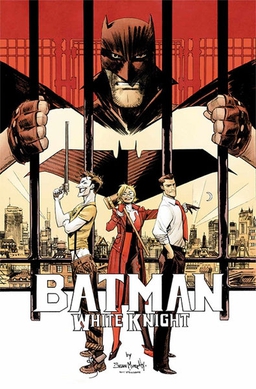
Batman: White Knight is an American comic book published by DC Comics. The eight-issue limited series, written and illustrated by Sean Murphy, began monthly publication in October 2017 and concluded in May 2018. In the series, the Joker is seemingly cured of his madness and sets out to become a politician under his real name of Jack Napier, seeking to change his public image as a "villain" and save Gotham City from Batman, whom he views as the real enemy of the city.
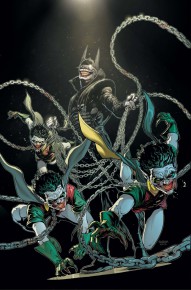
The Batman Who Laughs is a supervillain appearing in American comic books published by DC Comics. Created by writer Scott Snyder and artist Greg Capullo, he is the evil counterpart and alternate version of Batman within the Dark Multiverse.
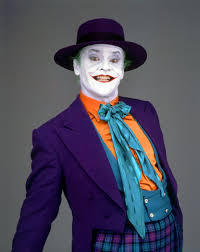
Jack Napier, also known as the Joker, is a fictional character introduced in the 1989 superhero film Batman, directed by Tim Burton. Primarily portrayed by Jack Nicholson, the character was based on the DC Comics supervillain the Joker. His name is a play on the word Jackanapes, as well as a reference to the names Jack Nicholson and Alan Napier, the latter having portrayed Alfred Pennyworth in the 1960s Batman TV series and having died the previous year. This depiction is notable for being one of the first adaptations of the character to have a distinct first and last name, as well as one of the few instances which show his origins. This iteration of the Joker is a psychopathic gangster who serves as the right-hand man of Gotham City crime boss Carl Grissom until he is disfigured following a confrontation with the vigilante Batman; his disfigurement drives him insane, and he becomes a costumed criminal obsessed with "out-doing" the Dark Knight, who he believes is getting too much press.
